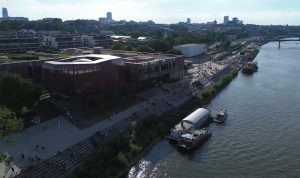How YouTube Learning Channels Inspire Education Apps as a remarkable convergence of digital innovation and educational enhancement. These channels have revolutionized the way learners interact with content, fostering an environment where traditional educational methodologies meet modern technology. By providing diverse resources and engaging formats, YouTube learning channels have not only democratized access to knowledge but have also profoundly influenced the development of various educational applications, creating a synergy that enhances learning experiences.
The impact of these channels extends beyond mere content delivery; they actively engage audiences through visual storytelling, interactive elements, and community participation. As educators and developers harness the insights gained from YouTube’s vast educational landscape, education apps are evolving to include features that promote collaborative learning, personalized feedback, and real-time interaction, thereby transforming the educational ecosystem.
The practice of sustainable architecture has gained significant traction in recent decades, driven by the urgent need to address environmental challenges and the pursuit of a more harmonious relationship between human habitation and the natural world. This article aims to delve into the principles, benefits, and developments within sustainable architecture, exploring how it shapes the built environment for future generations.### Understanding Sustainable ArchitectureSustainable architecture is an approach that considers the environmental impact of building design and construction, integrating eco-friendly practices to minimize energy consumption, reduce waste, and utilize sustainable materials.
It extends beyond mere energy efficiency to encompass a holistic perspective that includes social, economic, and environmental considerations. The core tenets of sustainable architecture include:
1. Energy Efficiency
The design of buildings that consume less energy for heating, cooling, and lighting, often achieved through advanced insulation techniques, energy-efficient windows, and the integration of renewable energy sources such as solar panels and wind turbines.
2. Sustainable Materials
The selection of building materials that are renewable, recycled, or sustainably sourced to lessen environmental impact. This includes materials such as bamboo, reclaimed wood, and recycled steel, which help to conserve resources and reduce carbon footprints.
3. Water Conservation
Implementing systems that reduce water consumption, such as rainwater harvesting, greywater recycling, and the use of drought-resistant landscaping, contributes to sustainable practices that protect vital water resources.
4. Site Responsiveness
Designing buildings that harmonize with their natural surroundings, taking into account local ecosystems, climate, and orientation to optimize natural light and ventilation. This also involves preserving existing vegetation and minimizing land disturbance.
5. Indoor Environmental Quality
Ensuring that the interior spaces provide healthy, comfortable environments for occupants by utilizing non-toxic materials, maximizing natural light, and ensuring adequate ventilation.### Historical ContextThe concept of sustainable architecture is not entirely new; its roots can be traced back to traditional building practices that were inherently sustainable due to their use of locally sourced materials and designs attuned to the environment.
However, the modern movement gained momentum in the 1960s and 1970s in response to widespread environmental concerns and the realization of the finite nature of our planet’s resources.Notable movements, such as the Green Building Movement, have emerged, advocating for principles of sustainability within the construction industry. Organizations like the U.S. Green Building Council (USGBC) and the World Green Building Council have played pivotal roles in promoting sustainable construction practices and certifying buildings through programs such as Leadership in Energy and Environmental Design (LEED).### Benefits of Sustainable ArchitectureThe adoption of sustainable architecture leads to numerous benefits for both the environment and human society.
Key advantages include:
1. Reduced Environmental Impact
By minimizing energy and resource consumption, sustainable buildings contribute to lower greenhouse gas emissions, thereby mitigating climate change impacts.
2. Economic Savings
Although initial investment costs may be higher, sustainable buildings often lead to long-term savings through reduced utility bills and maintenance costs. Additionally, green buildings can enhance property values and attract tenants or buyers who prioritize sustainability.
3. Enhanced Wellbeing
Sustainable architecture promotes healthier living conditions through improved air quality, natural lighting, and biophilic design, which incorporates elements of nature to enhance mental well-being.
4. Community Resilience
Sustainable architecture fosters resilient communities by encouraging sustainable urban planning practices that prioritize public transport, walkability, and access to green spaces.
5. Innovation and Job Creation
The shift towards sustainable building practices has spurred innovation in materials and construction techniques, creating new job opportunities within the green economy.### Current Trends in Sustainable ArchitectureAs the field of sustainable architecture evolves, several trends have emerged that reflect the ongoing commitment to eco-friendly design:
1. Net-Zero Energy Buildings
Aiming to produce as much energy as they consume over a year, net-zero energy buildings are at the forefront of sustainable architecture, employing advanced technologies to achieve this goal.
2. Smart Buildings
The integration of technology in building design enhances energy efficiency through smart systems that monitor and optimize energy use, lighting, and climate control automatically.
3. Adaptive Reuse
This trend involves repurposing old buildings for new functions, reducing waste and preserving cultural heritage while meeting modern sustainability standards.
4. Green Roofs and Walls
Incorporating vegetation into building designs not only improves aesthetics but also enhances insulation, reduces stormwater runoff, and contributes to urban biodiversity.
5. Community-Centric Design
Emphasizing the importance of community involvement in the design process, architects are increasingly focusing on creating spaces that meet the needs of the community, fostering social interaction and cohesion.### Challenges and Future DirectionsDespite the clear benefits of sustainable architecture, several challenges persist in its widespread adoption. These include:
1. Initial Costs
The upfront costs of implementing sustainable designs and materials can be a barrier for many builders and developers, despite the long-term savings they offer.

2. Regulatory and Policy Frameworks
Inconsistent building codes and regulations can hinder the implementation of sustainable practices. Advocating for comprehensive policies that support sustainability in the construction sector is essential.
3. Awareness and Education
Many stakeholders, including builders, architects, and clients, require greater awareness and understanding of sustainable architecture principles to make informed decisions.
4. Technological Advancements
Continued research and innovation are necessary to develop new materials and technologies that can enhance sustainability in construction.### ConclusionSustainable architecture represents a critical intersection between design, environmental stewardship, and social responsibility. By embracing sustainable principles, architects, builders, and communities can create spaces that not only fulfill immediate needs but also contribute to a more sustainable future. As the challenges of climate change and resource depletion become increasingly pressing, the commitment to sustainable architecture will play a pivotal role in shaping resilient and thriving communities.
The future of architecture lies in its ability to harmonize human activity with the natural world, ensuring that generations to come can inhabit spaces that are not only functional but also sustainable.





